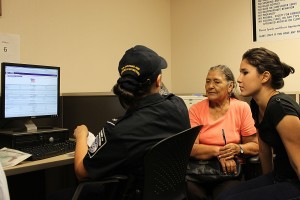- Slug: BC-CNS-Border Program,550
- Sidebar: Facts about the SENTRI program.
- Photos available (thumbnails, captions below)
By REBEKAH ZEMANSKY
Cronkite News Service
SAN LUIS – Jorge Quintero patiently works through screen after screen of personal questions about his background, residency and employment.
There are 16 sections total – and once he answers all the questions for himself, he will start again for his wife and each of their two children.
It’s a time-consuming process, but if it works it will save time for Quintero and others who now spend hours each week waiting to cross the border.
“This is an opportunity to spend less time in the line,” Quintero said.
He is applying to the Secure Electronic Network for Travelers Rapid Inspection program, or SENTRI, which will speed up the process of border crossing for those who qualify.
And less time in line for those who qualify for SENTRI means more time for border protection officials to spend on security.
“We can actually spend our time where it’s more needed, on those who may be possibly attempting to do something,” said Teresa Small, a spokeswoman for U.S. Customs and Border Protection in San Luis.
The new program is designed to cut wait times by running extensive background checks once, in advance – and then letting qualified travelers use a dedicated entry lane with a processing time of about 10 seconds. The approval is good for five years.
San Luis joins ports in Texas and California that operate SENTRI. Once approved, travelers can use the dedicated SENTRI lane at any of these ports.
After accepting applications for about a year, San Luis opened its pedestrian crossing this week. It’s expected to be fully operational this fall, along with a planned vehicle crossing, Small said.
The program is open to citizens with passports and others with legal documents like visas or green cards.
Quintero, who heard about SENTRI on the radio, came Tuesday to fill out applications for his family, which crosses as often as twice a week.
While people can start the application online from any location, San Luis is launching an outreach program timed with the opening of the pedestrian lane. At locations like the San Luis Youth Center, officers help people like Quintero navigate the online application.
“We’re going to have more (outreach), we will make it available to the general public in the weeks to come,” Officer Antonio Arellano said.
The Macias family also heard about SENTRI on the radio. Maria, Antonio and their daughter Vanessa came from Gaston to apply because they cross the border nearly every weekend to visit family, Vanessa said.
Maria and Antonio remember the SENTRI lane they saw on a trip to Texas.
“I saw people went faster,” Maria said, adding that on their last trip they waited “maybe three hours” to cross and come back home.
Both Quintero and the Macias family said they may cross more often if their SENTRI applications are approved.
Small hopes that once people see the lane working in San Luis they’ll think about applying for SENTRI. The large signs posted by the general line may already be having an effect.
Roberto Flores crosses the border every day in San Luis. He lives in Mexico but works and banks in the United States.
“Sometimes I have to wait 45 minutes,” Flores said.
Flores said he’s seen the SENTRI sign and knows it may cut down on the time he spends in line each day.
Will he apply?
“Maybe.”
^___=
SENTRI program steps:
– Apply online or in person.
– Provide evidence of citizenship or of immigration admissibility.
– Provide evidence of employment or financial support.
– Provide evidence of residence.
– Submit to Interview by Customs and Border Protection.
– Submit to photograph for identification card.
– Submit to fingerprinting.
– Receive an RFID-enabled identification card.
– Pay up to $122.25 per person in application fees.

A Customs and Border Protection officer checks a passport at the port of entry in San Luis. The SENTRI program, designed to speed trips across the border, is intended for U.S. citizens as well as Mexican citizens with visas and green cards. (Cronkite News Service Photo by Rebekah Zemansky)

A sign for the SENTRI program greets people crossing into the United States through the port of entry at San Luis. The program is intended to save people time crossing the border by reviewing their background information and embedding it in a microchip. (Cronkite News Service Photo by Rebekah Zemansky)

In San Luis, Ariz., Lurcero Cortez (right) and her grandmother get help from a Customs and Border Protection officer entering an application for a program intended to help people with U.S. government approval pass quickly through border ports of entry. The SENTRI program enters a participant’s information on a microchip, sparing them from background checks and long lines. (Cronkite News Service Photo by Rebekah Zemansky)